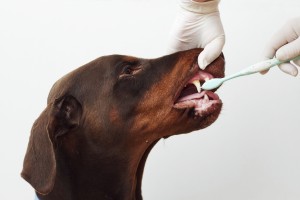Pet Dental Care & the Importance of Brushing Your Pet’s Teeth
 Brushing your pet’s teeth is probably right up there with changing your car’s oil. You can do it, but you really don’t want to. Unfortunately, without consistent dental care your pet’s mouth can harbor bacteria and decay; which cannot only be painful, but even dangerous to overall health.
Brushing your pet’s teeth is probably right up there with changing your car’s oil. You can do it, but you really don’t want to. Unfortunately, without consistent dental care your pet’s mouth can harbor bacteria and decay; which cannot only be painful, but even dangerous to overall health.
Dental Diseases Common to Pets
Humans aren’t the only ones who have to worry about plaque, tartar, and gingivitis. Many teeth and gum diseases that affect us also can affect our pets when oral hygiene and teeth cleaning are ignored.
Some of the more common dental issues that we see among cats and dogs include:
- Broken, worn, or cracked teeth
- Gingivitis
- Periodontal disease
- Ulcers
- Abscesses
For a list of associated symptoms to look for, refer back to our blog Why Pet Dental Care Matters.
Once your pet succumbs to one or more of these conditions, the threat of infection comes into play. Left untreated, infections can spread to the internal organs or systems, and even threaten the heart.
Thankfully, many of these dental diseases can be prevented through pet dental care – and that includes brushing your pet’s teeth daily.
How to Brush Your Pet’s Teeth
Dang those opposable thumbs our pets lack! Otherwise, we would simply give them the brush and paste. But, before you think pet tooth brushing is impossible – it really can be done – you should know that eventually your pet will acclimate to the feel of the brush and the daily routine.
Before you begin, you will need to purchase a quality toothbrush and paste formulated for dogs or cats – this is important, as human pastes will make your pet sick. Some brushes are designed to accommodate variations in breeds, too.
- Find a quiet room with few distractions (or escape routes)
- Start slowly by using a finger brush (often a plastic or rubber piece that slips over your index finger) to get your pet used to the feeling.
- To gain access to back upper teeth, carefully wrap your palm around the bridge of your pet’s nose and lift or curl the upper lip. For lower teeth, use the palm cupping process across the muzzle, then curl down your pet’s lower lip.
- Gradually increase the time you spend holding your pet’s mouth open until he or she is more comfortable with this.
- Slowly introduce the toothbrush by focusing on the canines and easy to reach teeth. Brush in a gentle circular motion.
- Once your pet is accustomed to this, try brushing outer and inner regions of the teeth.
- During the entire process, use a calm voice to praise your pet and reassure him or her.
- After you are done, consider rewarding your pet with a walk or snuggle time on the couch so he or she associates the brushing with something very positive.
For some extra pointers on pet dental care, the American Veterinary Medical Association (AVMA) offers an instructional video on daily cat and dog tooth brushing.
Brushing your pet’s teeth may be a little challenging at first, but with a bit of patience and planning, your pet will adjust. And, you will feel good knowing you’re taking a proactive, preventive approach to numerous diseases linked to pet dental disease.
If your pet is experiencing discomfort or you have noticed tooth decay, tooth discoloration, or bad breath, please call your Leon Valley Veterinary Hospital team to make an appointment.


